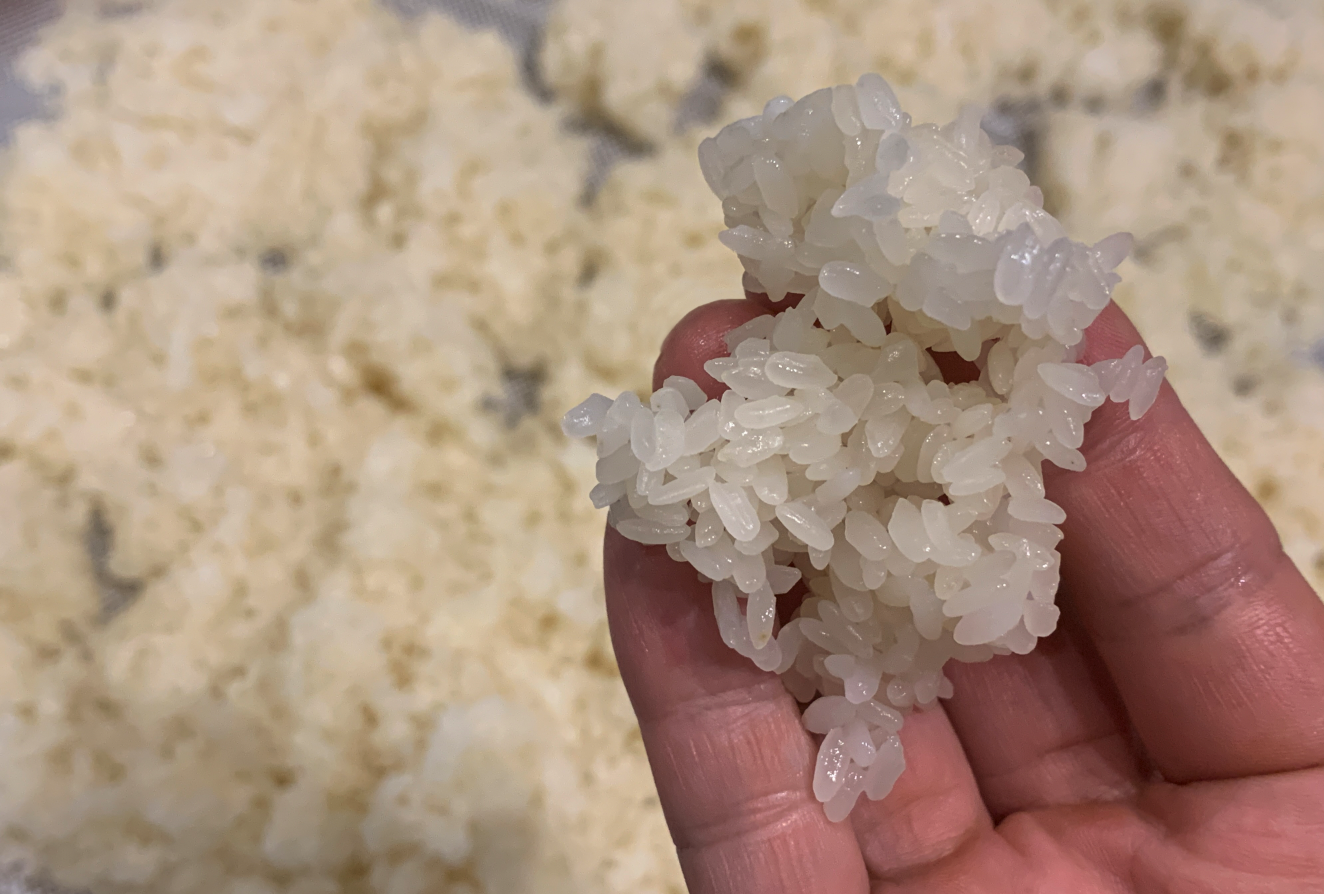4인 가족을 기준으로 할 때, 보통 가정에서 밥을 지으면서 쌀을 1kg 이상 씻는 경우는 드물다. 또 설사 그 만큼을 해야 하는 경우가 있다 손 치더라도 식사용으로 짓는 밥과 양주용 술밥은 조리하는 데 차이가 있다. 때문에 이 페이지에서는술밥을 지을 때 염두에 둘 점을 살펴보기로 한다.
A kilogram of rice is a lot for a small family to cook for dinner. And even when an occasion arises that calls for preparing a large batch, cooking rice to eat as a meal is rather different than cooking rice for suul. So, to understand the difference between the two, it is helpful to examine the following characteristics of rice that is cooked specifically to form suul.
대개 술밥을 할 때 고두밥을 해야 한다고 하는데 고두밥이란 밥물을 적게 넣고 지은 꼬들꼬들한 상태의 밥을 말한다. 경험측상 술밥을 이렇게 짓는 이유는 밥알 끼리 서로 붙어 있으면 술이 되는 과정에서 물에 풀어진 누룩이 골고루 밥알에 접촉을 하기 어렵기 때문인 것으로 보인다. 게다가 물기가 많은 진 밥은 당화와 알코올 발효 속도가 빨라 깊은 풍미를 내는 데 한계가 많다. "갑자기 일이 생겨 하룻만에 술을 빚어 낼라치면 진밥도 안 되고, 죽을 쑤어 빚어야 한다"는 어른들의 말씀을 새겨보면 내 짐작은 어느 정도 신빙성을 띤다. 사실 진밥이든, 고들고들한 고두밥이든 모든 밥알이 규질한 상태라면 그리 고민할 바가 아니다. 그러나 몇 천 알갱이도 넘을 것 같은 그 밥알들을 한 알 한 알 동일한 상태로 만든다는 것은 내가 할 수 있는 한 불가능에 가깝다.
Cooked rice used in brewing suul is often referred to as 술밥(Suul Bap) or 고두밥(Godu Bap), which is a type of cooked rice that is harder than what is usually eaten with a meal. Godu Bap is made with less water than regular cooked rice, and is, as a result, less sticky. This difference of texture serves to make the cluster of cooked rice easily separable, and ensure equal distribution of the grains when mixed with liquid and nuruk to form suul.
Godu Bap, May 2020, Los Angeles
1. 지난 블록 포스팅, 술을 빚기 위해 쌀 씻는 방법 / A Way of Washing Rice to Form Suul, 에서 설명한 대로 씻은 쌀을 충분히 받혀 물기를 뺀 후 쌀양의 1.5배 용량의 찜기에 물을 붓고 센불로 끓인다. 찜기에 넣는 물의 양은 한시간 이상 끓여도 졸아들지 않게 충분히 잡되 그 수면을 쌀이 있는 부분과 충분히 띄워야 끓는 물이 쌀에 튀어 어르지 않는다. 끓는 물이 쌀에 닿으면 닿는 부분은 죽이 되어 술 빚을 때 당화와 발효가 불규칙적으로 일어 나게 된다. 물이 펄펄 끓을 때 조심히 밑에 구멍이 뚫린 찜기를 올리고 물에 적신 밥보자기를 깐다. 밥보자기는 실리콘이나 폴리에스터 등 밥알이 붙지 않는 재질로 된 것이 좋다. 밥보자기는 찜통 지름의 두배 정도 되는 것을 쓰는 것이 좋은데 그 이유는 다 쩌진 밥을 식힐 채반으로 올길 때 보자기의 양쪽 네 귀를 잡고 위로 올리면 뜨거운 찜통에서 들어내기가 쉽기 때문이다.
As noted in the last blog post, 술을 빚기 위해 쌀 씻는 방법 / A Way of Washing Rice to Form Suul, the cleaned rice must be drained and steamed over high heat, using a steamer that is at least 1.5 times bigger than the volume of the cleaned and soaked rice. There should be enough water in the steamer to last at least one hour at a high boil, and the rapidly boiling water must be distanced far enough from the rice to avoid splattering it with hot water. If the boiling water comes in contact with the rice in the steamer, the rice will breakdown and become a sticky blob, causing uneven fermentation when it is mixed with nuruk. Once the water comes to a rapid boil, carefully place the steamer above it, and line it with a soaked rice net to prevent rice from sticking to the steamer. The rice net should be made out of silicon or polyester material, and about twice the diameter of the steamer. The extra length of the rice net also comes in handy after steaming, when transporting the hot rice to the cooling rack.
2. 채반에서 충분히 물을 밭친 깨끗한 씻은 쌀을 밥보자기에 쏟기 전에 채반 밑을 손으로 툭툭쳐서 물방울이 떨어지도록 한다. 씻은 쌀에 물기가 많이 남아 있으면 찜기 안에서 쌀알 사이에 수막을 형성해 밥이 골고루 익는 것을 방해 할 수 있다. 쌀을 넣고 뚜껑을 덥기 전에 밑에서 올라올 증기가 쌀이 있는 부분으로 잘 올라 올 수 있는지 재차 확인한다. 혹시 용량이 적은 찜통을 2단으로 쌓아서 사용 할 때는 중간에 김이 이음새로 새지 않게 조심하고 아랫단에 전체 쌀량의 45% 윗단에 55%를 넣으면 골고루 익는다. 밥보자기로 쌀을 덥고 냄비 뚜껑을 꼭 닫는다. 맵쌀은 1시간, 찹쌀은 30분 정도 찐다. 밥을 여러번 하다 보면 밥이 되는 냄새만 맡아도 밥이 되는 과정을 짐작할 수 있다. 밥이 쪄 지는 동안 중간에 뚜껑을 열어 보아서는 안된다. 밥이 골고루 잘 익었는지 재빨리 확인하고 불을 끈 후 주걱으로 밥을 빨리 뒤집고 다시 뚜껑을 닫고 15분 동안 뜸을 들여야 한다. 처음 써 보는 찜기로 밥을 찔 때는 위의 시간을 기준으로 해 보고 필요하면 차 후엔 시간을 조정한다.
Tap the bottom of the strainer that contains the washed rice to drain the excess water before pouring the rice into the lined steamer. This minimizes the possibility of forming a water-film, which can obstruct the smooth flow of the hot steam. After pouring the rice, check the flow of the steam before closing the lid. If you are using a double-tiered steamer and need to divide the rice into two levels, place about 45% of the rice on the bottom layer and 55% on the top layer. Gather the corners of the rice net over the rice to cover the grains, and close the steamer lid tightly. Cook sweet rice for 30 minutes and regular rice for 1 hour. As you gain experience and confidence in the brewing process of suul, you will be able to judge the doneness of rice simply by its scent. Never open the lid during the steaming process--when the time arrives, use a spatula to quickly check for doneness, then turn off the heat. Turn the rice with the spatula, using a gentle hand as not to break the fragile rice grains, then close the lid tightly and let it sit for 15 more minutes. Every bag of rice, household, and atmosphere is different; if you are steaming rice for the first time, use the above directions as a starting point, and adjust the cooking time as needed to best fit you and your environment.
3. 밥이 되는 동안 더운 밥을 식힐 채반을 준비한다. 물을 머금고 익은 뜨거운 밥은 수증기를 대기중으로 발산 하고 더운 김은 빠른 속도로위로 솟는다. 이 더운 김을 빠르고 효과적으로 대기로 날려 보내지 못하고 계속 밥알 사이에서 맴돌게 하면 잘 지어진 밥도 질어 질 수 있다. 따라서 밥을 잘 짓는 것도 중요하지만 다 된 밥을 잘 식히는 것 또한 매우 중요하다. 밑술이나 범벅에 밥을 넣기 전에 식히는 이유는 누룩의 효모가 대개 37˚C에서 작용을 중단하고 50˚C 부터는 사멸되기 때문이다. 밥이 충분히 식었는지 식별하는 방법 중 가장 손쉬운 방법은 손등을 밥에 대 보아 체온과 비교해 보는 방법이다. 밥을 식힐 채반 밑에도 공기가 통할 수 있게 나무 토막이나 종이컵 등을 괘서 바닥에서 띄우는 게 좋다. 채반 위에는 물에 적신 밥보자기를 넓게 편다. 찜통에서 밥보자기의 네 귀를 들어 뜸든 밥을 식힐 채반위의 밥보자기에 조심히 그러나 재빨리 뒤집어 쏟는다. 더운 여름엔 밥이 더디게 식으므로 선풍기나 부채로 바람을 불어 식히나 밥알이 마르지 않게 멀리서 바람을 쏘여야 한다. 밥을 식히는 동안 밥 주걱으로 밥을 뒤집어 밑에 깔린 밥알들에 수분이 고이지 않게 하고 되도록 넓게 펴서 빨리 식을 수 있게 도와주는 것이 좋다. 밥을 뒤적일 때 밥알이 깨어지지않게 조심한다.
While the rice is being steamed, prepare the cooling rack. Steamed rice will release hot water vapor as soon as it comes out of the steamer. If the hot steam is trapped between the cooked rice grains, even perfectly-steamed rice can become watery and sticky. Therefore, it is just as important to cool rice correctly as it is to steam it well. The rice must be cooled before it is added to mitsuul or beombeok, because the yeast in nuruk becomes inactive at 37˚C, and starts to die at 50˚C. The easiest way to check if the rice has cooled enough is simply to touch it with back of your hand. Place wooden blocks or paper cups under the corners of the cooling rack to elevate it; the space created between the rice and the counter will result in better air flow. Then, spread a damp rice net over the cooling rack. Transport the steamed rice from the steamer by holding the four ends of the rice net, bringing it to the rack, then carefully but quickly turn out the rice onto the cooling rack. If using an electric fan or hand fan to help cool the rice in hot weather, be careful not to dry out the rice. Use a large spatula to constantly turn the rice, spreading it as thinly as possible on the cooling rack so that the grains can come in contact with the open air from the top and bottom. Use caution not to break the cooked rice grains.
4. 밥이 충분히 식는 동안 밑술이나 범벅이 든 발효조를 밥 가까이 놓아 밥을 넣을 때 흘리지 않게 한다.
When the rice has cooled, move the brewing pot containing the mitsuul or beombeok closer to the cooling rack so that rice can be easily added to the container without spillage.

